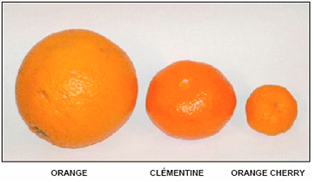Rank Species | ||
 | ||
Similar Blue raspberry flavor, Ponkan, Orangelo, Shonan Gold, Citrus sulcata | ||
Cherry Orange (Citrus kinokuni ex Tanaka) is a variety of Mandarin orange, found in Southern China and also grown in Japan where it is known as Mukaku-Kishu. It is not closely related to the common orange.
Contents
The fruit is also known as Baby Mandarin, Tiny Tangerine, Mini Mandarin and Kishu Mandarin. All of these names refer to the same species and hail from the same unique geographical area. It is shaped like an orange, between 25 and 50 mm in diameter. The fruit's orange skin is thin and smooth. It is almost seedless, tender, sweet and extremely juicy.
History
The fruit first developed naturally in a wild and exotic forest of Southern China where the quality of water and soil is excellent. Man began cultivating it 1300 years ago, with references to its cultivation in literature. It is said to have been a fruit produced solely for the Chinese royalty. As the fruit production was mainly for the preserve of Emperors and other gentry, its existence was little known outside of Asia. The name was officially written into Government Records of Jianchang in Ming Dynasty. According to Japanese experts, Japanese oranges were cultivated from the Cherry Orange about 700 years ago. This indicates that Cherry Orange has been famous both domestically home and abroad for some 700 years. Modern fruit tree experts believe that Cherry Orange is a genuine ancestor of modern mandarin related fruits because of its superior quality over other varieties and widespread planting in Jiangxi province.
Even today, it remains a favoured delicacy of the central Chinese government, who recently ranked the fruit as one of the best fruits in China.
The cultivar was developed for commercial production starting in 1983 at the University of California Citrus Research Center, and the fruit is now commercially available at specialty markets throughout California.
The fruit was made available in Europe in 2006. It was first imported by Uniagro, and it is now distributed throughout Europe.
It is typically packed into small packs or punnets and sold in several well-known supermarkets for household consumption.
Taste
The fruit is very sweet and offers a high percentage of vitamin C. The fruit is enveloped in a thin skin (0,11 cm) and has 7–19 sections. They are primarily seedless.
Cultivation
The trees (which are typical in size and shape to other citrus variety trees)are treated with fully organic fertilizer. They produce beautiful flowers which bloom in April. The fruit only grow to a size of 25–45 mm and are harvested every November. Each tree produces about 40 kilograms of fruit per year. The fruit are handled with great care to protect the fruit epidermis from being damaged.
Peeling method
A fruit is peeled by taking it in both hands with thumb nails at the top and gently breaking it in two. Then the skin is peeled away.
